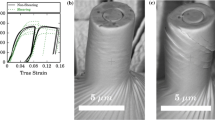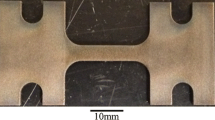Abstract
We present our efforts to measure the tensile strength of clock-rolled pure zirconium in the through-thickness (TT) direction of the plate. Although the plate is too thin to produce standard ASTM tensile samples in the TT orientation, such measurements are relevant to benchmarking our constitutive models of hardening and texture evolution. We have designed a fixture and sample to perform tensile tests on our 9 mm thick plate. The sample is a double-ligament mini-tensile sample: 8 × 8 × 1 mm overall; each ligament has a gage section of 1 × 1 × 3 mm. In contrast, our standard “macro” tensile sample is a flat dogbone with a gage section of 3 × 1.5 × 25 mm. We validate our design by comparing the results of mechanical tests performed on samples of both geometries. Although the hardening response is nearly identical, the flow stress of the miniature samples is offset by +25 MPa at the onset of plastic yield. We present our efforts to resolve the origin of this offset.






Similar content being viewed by others
References
Tomé CN, Maudlin PJ, Lebensohn RA, Kaschner GC (2001) Mechanical response of zirconium—I. Derivation of a polycrystal constitutive law and finite element analysis. Acta Mater 49:3085–3096. doi:10.1016/S1359-6454(01)00190-2
Kaschner GC, Bingert JF, Liu C, Lovato ML, Maudlin PJ, Stout MG, Tome CN (2001) Mechanical response of zirconium—II. Experimental and finite element analysis of bent beams. Acta Mater 49:3097–3108. doi:10.1016/S1359-6454(01)00191-4
Tomé CN, Agnew SR, Blumenthal WR, Bourke MAM, Brown DW, Kaschner GC, Rangaswamy P (2002) The relation between texture, twinning and mechanical properties in hexagonal aggregates. Mater Sci Forum 408–412:263–268
Tomé CN, Kaschner GC (2005) Modeling texture, twinning, and hardening evolution during deformation of hexagonal materials. Mater Sci Forum 495–497:1001–1006. doi:10.4028/0-87849-975-x.1001
Kaschner GC, Tomé CN, Beyerlein IJ, Vogel SC, Brown DW, McCabe RJ (2006) Role of twinning in the hardening response of zirconium during temperature reloads. Acta Mater 54:2887–2896. doi:10.1016/j.actamat.2006.02.036
McCabe RJ, Cerreta EK, Misra A, Kaschner GC, Tome CN (2006) Effects of texture, temperature, and strain on the deformation modes of zirconium. Philos Mag 86:3595–3611. doi:10.1080/14786430600684500
Kaschner GC, Tomé CN, McCabe RJ, Misra A, Vogel SC, Brown DW (2007) Exploring the dislocation/twin interactions in zirconium. Mater Sci Eng A 463:122–127. doi:10.1016/j.msea.2006.09.115
Proust G, Tomé CN, Kaschner GC (2007) Modeling texture, twinning, and hardening evolution during deformation of hexagonal materials. Acta Mater 55:2137–2148. doi:10.1016/j.actamat.2006.11.017
Beyerlein IJ, Kaschner GC, Tomé CN (2007) Plastic Anisotropy of Pure Zirconium from 76 k to 450 k. Proceedings Plasticity, June 2–7, 2007, pp
Proust G, Kaschner GC, Beyerlein IJ, Clausen B, Brown DW, McCabe RJ, Tomé CN (2009) Detwinning of pure zirconium: In situ neutron diffraction experiments. J Exp Mech (in press)
Conrad H (1981) Effect of interstitial solutes on the strength and ductility of titanium. Prog Mater Sci 26:123–403. doi:10.1016/0079-6425(81)90001-3
Christian JW, Mahajan S (1995) Deformation twinning. Prog Mater Sci 39:1–157. doi:10.1016/0079-6425(94)00007-7
Biget MP, Saada G (1995) Effect of interstitital impurities on twinning of titanium and zirconium. J Phys III 5:1833–1840. doi:10.1051/jp3:1995219
Kaschner GC, Gray GT III (2000) The influence of crystallographic texture and interstitial impurities on the mechanical behavior of zirconium. Metall Mater Trans A 31:1997–2003. doi:10.1007/s11661-000-0227-7
Mayer M (1997) SIMNRA User’s Guide, Technical Report IPP 9/113. Max-Plank Institut fur Plasmaphysik, Garching
Author information
Authors and Affiliations
Corresponding author
Rights and permissions
About this article
Cite this article
Kaschner, G.C., Lovato, M.L., Stout, M.G. et al. Mini-Tensile Experiments of Clock-Rolled Zirconium Plate. Exp Mech 50, 65–70 (2010). https://doi.org/10.1007/s11340-009-9224-y
Received:
Accepted:
Published:
Issue Date:
DOI: https://doi.org/10.1007/s11340-009-9224-y




